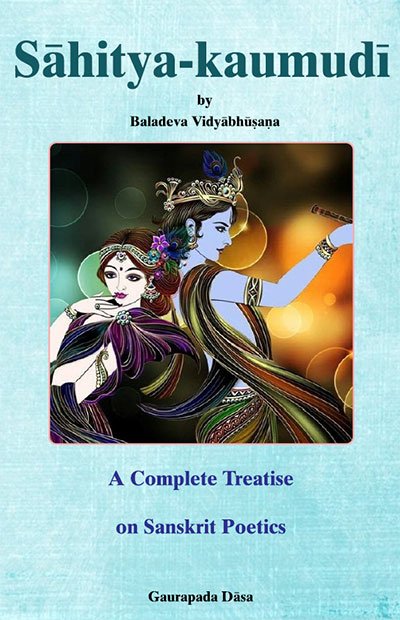Sahitya-kaumudi by Baladeva Vidyabhushana
by Gaurapada Dāsa | 2015 | 234,703 words
Baladeva Vidyabhusana’s Sahitya-kaumudi covers all aspects of poetical theory except the topic of dramaturgy. All the definitions of poetical concepts are taken from Mammata’s Kavya-prakasha, the most authoritative work on Sanskrit poetical rhetoric. Baladeva Vidyabhushana added the eleventh chapter, where he expounds additional ornaments from Visv...
Text 2.34
न चानुमानं व्यङ्ग्यस्य बोधकम्, तत्-परस्परायाम् अनेकानुमान-कल्पने गौरवात्. तथा हि,
na cānumānaṃ vyaṅgyasya bodhakam, tat-parasparāyām anekānumāna-kalpane gauravāt. tathā hi,
An inference cannot make one understand an implied sense, since it is cumbersome to imagine many inferences in succession. Let us take this verse as an example:
manas tava manasvinyā malinaṃ na vapus tathā |
yat pāda-nakharāḥ kṛṣṇaṃ śliṣyanti pratibimbitam ||
“Since You are a māninī, Your heart, not Your body, is in turmoil, because Your foot nails embrace Kṛṣṇa, who is mirrored on them.” (adapted from Alaṅkāra-kaustubha 2.33)
atra pāda-nakharā iti mānād āvṛta-sarvāṅgatvaṃ mudrita-netratvaṃ ca, anyathā pādopānta-gata-kṛṣṇa-vīkṣāsahiṣṇutvopapatteḥ. paścāt sakhī-vacasā satvaraṃ pāda-saṃvṛttiś ca, tato māna-śaithilyam, kṛṣṇasya ca praṇayaja-vinaya-mahimnā pādāntikam upetyāpi tat-sparśākṣamatvam, sakhyāś ca tat-pakṣa-pātitvaṃ sva-sakhīmāna-hāni-sāgrahatvaṃ cety-ādīni vastūny anekānumānaiḥ sādhyānīti gauravam. vyañjanā-vādinas tv ekayaiva vyañjanayeti lāghavāt saiva śreyasīti.
Here, the phrase “Her foot nails” signifies that on account of pique all Her limbs are covered and Her eyes are closed. Otherwise, if Her eyes were open, it would not make sense to say that She would be able to tolerate seeing Kṛṣṇa, who had gone near Her feet. Subsequently, owing to the sakhī’s remark She experienced a mental flurry and covered Her feet. Afterward Her pique abated, and Kṛṣṇa, though He had come near Her feet by virtue of His great humility born of intimate love, was unable to touch Her feet. Moreover, the sakhī is on His side, and she was eager to diminish her friend’s pique.
All these ideas and more would have to be proven with many inferences. That is cumbersome. However, those who propound Suggestiveness (vyañjanā) achieve them with only one vyañjanā. Therefore, owing to conciseness, vyañjanā is best.
Commentary:
The last paragraph of Baladeva Vidyābhūṣaṇa’s elaboration is a paraphrase of Alaṅkāra-kaustubha 2.33. He and Kavikarṇapūra seek to avoid the fault of using a rhetorical function more than once. If anumāna were selected instead of vyañjanā as the method for proving an implied sense, then the fivefold Vedic syllogism (pratijñā, hetu, udāharaṇam, upanayanam, nigamanam) would have to be posited for each one. By the model of that procedure, one application of Suggestiveness makes only one implied sense.
Further, Mammaṭa and Viśvanātha Kavirāja say that sometimes anumāna cannot match vyañjanā because in the context of śṛṅgārarasa, for instance, a certain predisposition, i.e. a subconscious impression (saṃskāra, or vāsanā), is needed to understand an implied sense: That is why Mīmāṃsakas are derided in poetics. According to Mammaṭa and Viśvanātha, another reason anumāna is sometimes not adequate to explain an implied sense is that there is not always an invariable factor that explains the implied idea, whereas in anumāna the conclusion must be certain; The words spoken by a character are not a valid basis for an inference. Mammaṭa and Viśvanātha also say that poetry is not meant to be a means of valid knowledge under all circumstances: It originates from a poet’s imagination, and so there is no fault if an implied sense is derived with a disregard for a strict logical reasoning (Kāvya-prakāśa, verse 138 vṛtti) (Sāhitya-darpaṇa 5.4).
In his explanation of Prabhākara’s Anvitābhidhāna-vāda, Mammaṭa shows these two verses to illustrate how the function of a means of knowing ceases:
śabda-vṛddhābhidheyāṃś ca pratyakṣeṇātra paśyati ||
śrotuś ca pratipannatvam anumānena ceṣṭayā ||
anyathānupapattyā tu bodhec chaktiṃ dvayātmikām |
arthāpattyāvabodheta sambandhaṃ tri-pramāṇakam ||“By pratyakṣa (direct sensory perception), the boy perceives the words, the two elders, and what is denoted by the word go (cow). By anumāna (inference), owing to the actions of the elder who was addressed, the boy ascertains that that elder, the hearer, has understood what he was told to do. And by arthāpatti (presumption), owing to occurrences that cannot be explained otherwise, the boy can understand the twofold power.[1] Thus the boy can fathom the relation, which comprises three means of obtaining knowledge, [between a word and its meaning]” (Kāvya-prakāśa 5.47).
By this model of the usage of pratyakṣa (direct sensory perception), it can be said that one application of Suggestiveness can yield more than one implied sense.
Footnotes and references:
[1]:
A word has a twofold power: (1) The capacity of being perceived, and (2) The capacity to cause the perception of a thing (the meaning of that word): Bhartṛhari writes: grāhyatvaṃ grāhakatvaṃ ca dve śaktī tejaso yathā | tathaiva sarva-śabdānām ete pṛthag avasthite || (Vākya-padīya 1.55)
